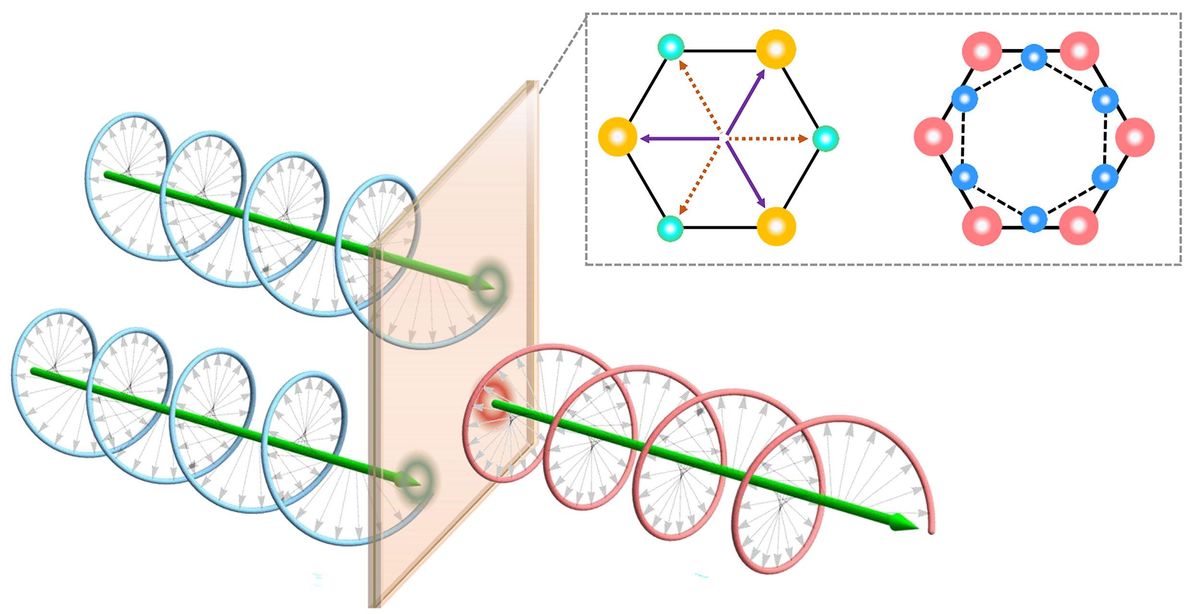By using light waves that essentially spiral through space like corkscrews, optical logic gates can run 1 million times as fast as their electronic counterparts, advancing the cause for ultrafast light-based computing, a new study finds. It also reveals a new and promising interface between optical computing and conventional electronic computing.
Modern electronics build logic gates from transistors to carry out logic operations such as AND, OR, and NOT. To create faster circuits, scientists have long investigated replacing electronic gates with light-based optical devices, says study lead author Yi Zhang at Aalto University, in Finland. These could theoretically operate more quickly, since photons travel at the speed of light, while electrons don’t.
In the new study, researchers explored using a property of light known as chirality. Light beams can be made to spiral much like threads on a screw, turning either clockwise or counterclockwise in a right- or left-handed circular polarization. (Do a “thumbs up” with your right hand. The direction in which your thumb points, compared with the direction in which your fingers curl, represents a right-circularly polarized wave’s corkscrew direction compared with its direction of propagation.)
Zhang and his colleagues created a gate from a single layer of molybdenum disulfide—consisting of a sheet of molybdenum atoms sandwiched between two layers of sulfur atoms—placed on top of silica. When the researchers shone two light beams at the gate, the handedness (also known as chirality) of the output beam was determined by the chirality of the input beams. When both input beams had the same chirality, the output was right-handed, but when both input beams had different chirality, the output beam was left-handed.
This new device served as one type of logic gate, XNOR. By adding filters or other optical components, the researchers created the remaining other kinds of logic gates, such as AND, OR, NOR, XOR, and NAND.
The new gates performed at speeds of less than 100 femtoseconds, which is roughly 1 million times as fast as electronic gates, Zhang says. Moreover, the scientists found they could achieve high-speed electric control of the gates simply by applying a voltage to the molybdenum disulfide.
“Traditionally, the connections between electronic and optical computing have mainly been realized through slow and inefficient optical-to-electrical and electrical-to-optical conversion,” Zhang says. “We demonstrate electrical control of the chirality optical gates, realizing an exciting prospect for direct interconnection between electrical and optical computing.”
In addition, the researchers showed that a single device could simultaneously run multiple gates. In contrast, previous electronic and optical gates each typically performed just one logic operation at a time, Zhang notes. These findings suggest that simultaneous multiple chirality logic gates could help build complex multifunctional circuits and networks, he says.
In the future, the researchers want to show their chirality logic gates can perform “cascading,” an operation that helps build large-scale circuits. Although previous optical gates have faced major difficulties while cascading, Zhang suggests that it theoretically should not be a problem with their devices.
Zhang notes that the biggest challenge they face is the very low efficiency of the nonlinear optical effect underlying their gate’s operation. “The good news is that there are several new materials reported recently that have high nonlinear conversion efficiency,” he says.
The scientists detailed their findings 9 December in the journal Science Advances.
This article appears in the February 2023 print issue as “These Optical Gates Provide Electronic Access.”
- Quantum Gate 100x Faster Than Quantum Noise ›
- Photon-Triggered Nanowire Transistors a Step Toward Optical ... ›
- All-Optical Computing Gets Another Arrow in Its Quiver - IEEE ... ›
Charles Q. Choi is a science reporter who contributes regularly to IEEE Spectrum. He has written for Scientific American, The New York Times, Wired, and Science, among others.



